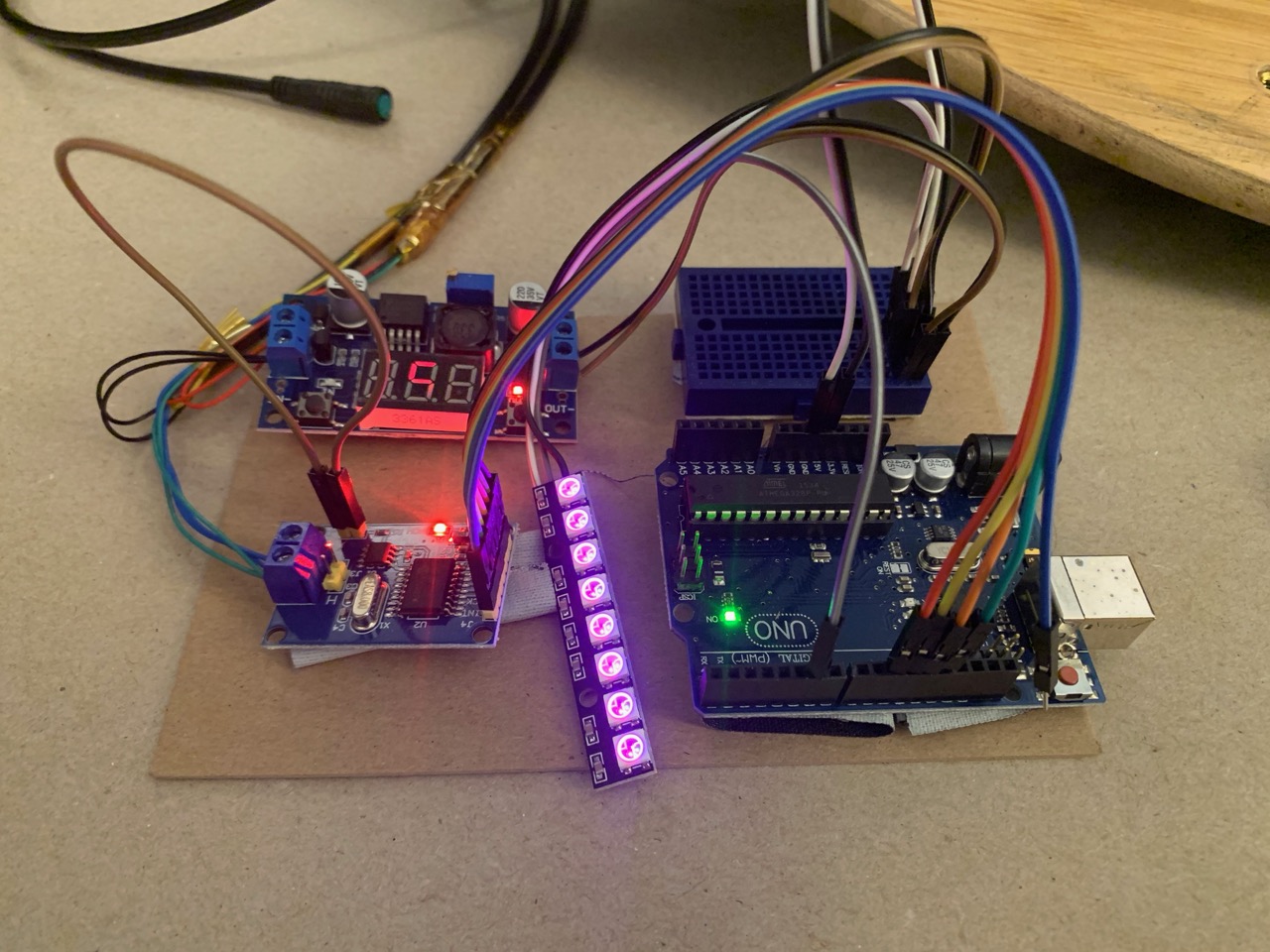The Boosted Board has two accessory connectors at the front and back of the board. The ESC needs firmware V2.7.2 to enable communication and provide power, and without the accessory registering, the board will cut power after 5 seconds.
I wrote a Beams Proof of Concept as an Arduino Sketch, available as beams_emulator.ino in this directory. The code is set up to work on an Arduino Uno, with a MCP2515 CAN transceiver board, and 8 WS2812B ("Neopixel") LEDs to act as a headlight, powered by the board through a buck regulator. To see a video demo, see this Tweet.
The board has two 4 pin connectors commonly used with eBikes, sometimes called "Julet 4 pin" (but not the Julet Mini) or "BAFANG 4 pin" cables. The connector carries a CAN pair, switched +15v, and ground.
The Accessory connector, like the BMS<->ESC communication, uses a CAN bus to communicate at 250kbaud, with extended IDs. An accessory has to register itself with the ESC within the first 10 seconds to keep the +15v rail active. Once any accessory registers itself with the ESC, the +15v rail will stay on until the board shuts down.
The ESC will continuously send an increasing counter value to the IDs in the range of 0x1039320N -- every half a second, a new timestamp will be sent to N+1, until it wraps back around to 0.
To register as the Front Beams, send (hex) [FE 00 00 00 00 00 37 13] to 0x10339200, to register as the Back Beams, send (hex) [FE 00 00 00 01 37 13] to the same address.
0xFE; // Accessory Init / Registration
0x00;
0x00;
0x00;
0x00;
0x00; // 00 is Headlights, 01 is Taillights
0x37; // Serial, LSB
0x13; // Serial, MSB
Once registered, the ESC will send events based on what has been registered -- if you only register headlights, it won't send brake light commands.
Messages from the ESC for the lights are 8 byte long. The first byte indicates which light the ESC is communicating with. Commands for the light that registers first start with 0x00, commands for the light registering second start with 0x01.
If you add a small delay to the back lights, they will always register second and receive messages starting with 0x01.
The second byte of light commands is always 0x04.
The third byte indicates the type of the command:
0x22: lights on
0x23: lights off
0x62: enable blinking
0x42: disable blinking
The fourth byte of the 'lights on' command (0x22) contains the brightness value of the lights. Scaling is different for front and back lights. Front lights use the whole byte's range of 0-255, back lights use 0-51 (0x0-0x33) for normal brightness values and 100 (0x64) when breaking.
So the different commands look like this:
Beams on/brightness change:
0x00 // front beams, 0x01 for back beams
0x04 // constant
0x22 // lights on command
0xff // brightness value, full brightness front
0xXX // no usefull information
0xXX // no usefull information
0xXX // no usefull information
0xXX // no usefull information
Beams off:
0x00 // front beams, 0x01 for back beams
0x04 // constant
0x23 // lights off command
0x00 // brightness value, off
0xXX // no usefull information
0xXX // no usefull information
0xXX // no usefull information
0xXX // no usefull information
Beams enable blinking:
0x00 // front beams, 0x01 for back beams
0x04 // constant
0x62 // lights blinking command
0xXX // no usefull information
0xXX // no usefull information
0xXX // no usefull information
0xXX // no usefull information
0xXX // no usefull information
Beams disable blinking/:
0x00 // front beams, 0x01 for back beams
0x04 // constant
0x42 // lights stop blinking command
0xXX // no usefull information
0xXX // no usefull information
0xXX // no usefull information
0xXX // no usefull information
0xXX // no usefull information
Possibly the easiest way to understand this is with a screen capture of cangaroo, a CAN capture program. The capture shows the headlight initialization at 0x10339200, and the rolling messages sent every half second with the IDs 0x1039320X. Additionally the Beams were turned on (0x10393204 and 0x10393205) and off (0x1039320B and 0x1039320C). The command messages can appear anywhere in the ID range, and parsing the first byte of the messages as well as the length seems to be the best way to parse the message.
The Accessory port provides +15v for the first 5 seconds of board power on without an accessory registering, and will continuously provide power if any accessory registers.
The official Beams have a USB-C port for charging accessories, and is rated for 5v 3A. Not pulling more than 15W from the Accessory connectors, combined, seems like a safe limit.


